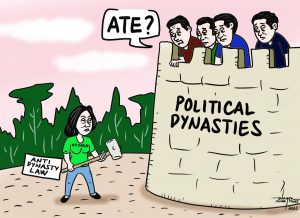Because we have a very popular and controversial Education Secretary, who is also the Vice-President of our country, talking about issues faced by the education sector is even more politically charged now than ever before.
Although that is just politics-as-usual in this country, our problems in education remain the same and we keep doing the same things over and over again expecting a different result, which is Albert Einstein’s definition of insanity.
Take for example the problem of lack of classrooms. According to Education Undersecretary Epimaco Densing III, in a story that came out on Business World in March, they need an annual budget of P100 billion to resolve classroom shortage by 2030 or in seven years. This year, they have a P15.6 billion budget to build 6,421 classrooms. Doing the math, that is an average cost of P2.4 million per classroom.
More than P2 million for a classroom seems ridiculous, right? But I discovered an explanation for that from 2012 when the late Senator Miriam Defensor Santiago thought that P1.1 million for a classroom then was too high and asked the Department of Education (DepEd) to detail the cost.
Then Education Assistant Secretary Tonisito Umali explained that P1.1 million was the weighted average of the single and two-story classrooms. A single-story classroom with toilet, furniture and fixtures was pegged at P730,000 while a two-story classroom with toilet, furniture and fixtures cost P1.25 million. The more stories, the higher the cost because of the foundation, the stairs, the ramp for persons with disability (PWD), and other features.
That was the cost in 2012, more than a decade ago. So P2.4 million per classroom now seems realistic. I wonder, though, how much percentage of that cost gets sucked into corruption.
The classroom shortage at the end of 2022 was pegged at 165,000. Undersecretary Densing said that if the budget remains at the current level, it will take more than 20 years to close the gap.
That is assuming there will be no other problems on the existing classrooms within that time period and no further increase in construction costs. It also assumes that all classroom construction projects are delivered as intended with no shenanigans involved whatsoever.
While the government is figuring out how to solve the classroom shortage, schools are resorting to cramming students as many as 60 in one room (ideal class size is 40-45); splitting a room into two; and employing double shifts of classes. Oftentimes, especially in rural areas, classes are held outdoors under a tree.
There is also the problem of available buildable space, especially in highly urbanized areas like cities in Metro Manila. The only solution is to build vertically, which is more expensive to construct. The taller the structure, the more safety and accessibility (like ramps and elevators) features are needed.
DepEd is now exploring the use of a hybrid setup like what they used during the COVID-19 pandemic lockdowns. Similar to the work-from-home arrangement, they are planning to institutionalize blended learning as a permanent mode of delivery.
Blended learning, as defined by DepEd, is a learning delivery that “combines face-to-face with any or a mix of online distance learning, modular distance learning, and TV/radio-based instruction.”
Studies have shown that blended learning improves learning and boosts engagement because it combines the best aspects of face-to-face teaching and online instruction in ways that enable students to learn at their own pace. It is a learning model that can work for diverse populations of students.
However, the application of blended learning here in the Philippines has not worked as intended. At best, what happened is simply swapping analog tools for digital ones. Our version of blended learning here is more often just recording a teacher’s lecture on video and watching that video on television or on a digital device. It is scanning pages of a textbook and creating a PDF file that you can read on your mobile phone or tablet.
A truly blended learning is not simply mixing technology and teaching. It is meaningfully combining in-person and online elements together to create a richer learning experience, not merely duplicating course content in different formats.
Then there are issues of internet connectivity and accessibility to digital learning devices to make learning truly interactive and engaging. The current digital divide is an added layer to the problem of access to basic education. And even if we have the right gadgets and connectivity, do our teachers and learners have the skills to navigate the digital world safely and effectively?
Sure, we can still learn using printed books, learning charts and modules but these educational materials will only work for independent and self-motivated learners with minimum supervision. The reality is most households are not equipped to handle learners who study-from-home. In fact, there are many learners who do not have their own homes or someone who can guide and help them with their learning outside the school.
Blended learning, as currently practiced in Philippine public schools, creates a new set of problems in ensuring every child’s right to basic education.
How will DepEd simultaneously fund the building of physical classrooms at the same time support the shift to blended learning as a mode of delivery? Will there be a gradual phasing out of printed books and modules and shifting to the use of video and online learning management systems? Will there be more investments in digital gadgets and internet connectivity? What does that plan look like in the next 10 to 20 years?
And that is just the mode of delivery aspect, what about the type and quality of education we are delivering to the learners? Will it be the same content created by our colonizers designed to make Filipinos conform to and serve the status quo?
Perhaps, the more important question we need to ask about education now is what are we teaching our students? Are we helping them become the citizens and leaders our country needs to be truly free, just, healthy, prosperous, and peaceful? Or are we teaching them the same old things and with the same thinking that created our problems in the first place?
Solving our problems in education needs more than building classrooms, hiring more teachers, or even increasing the budget. It needs a genuine transformation of our entire system.



